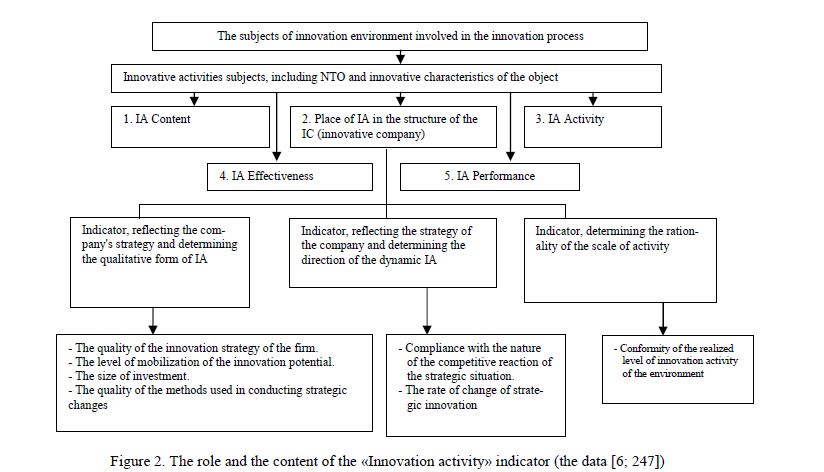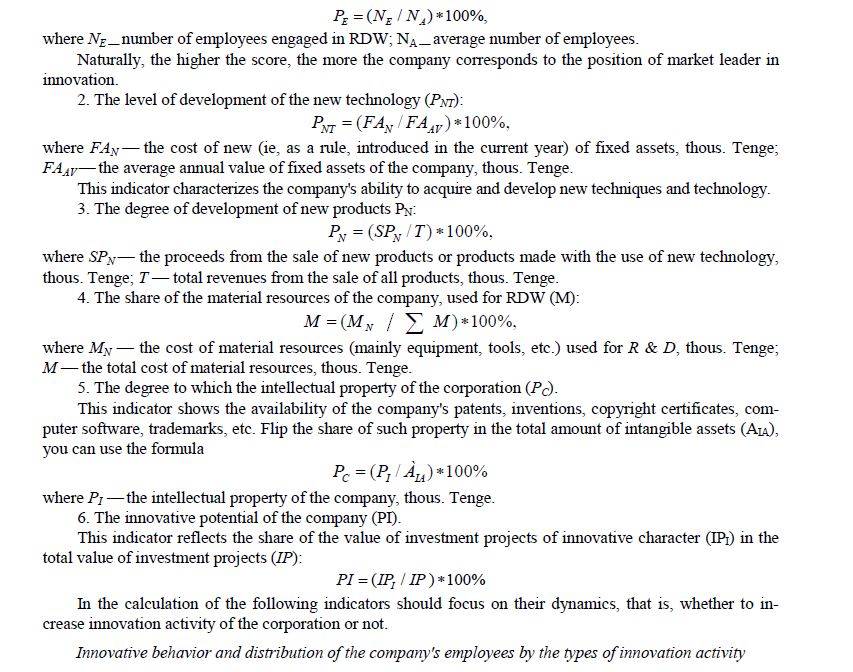It is noted that the innovative capacity of the enterprise is characterized by its ability to develop and introduce innovations in various fields of activity. It is emphasized that the assessment of innovative potential is necessary for determination of Innovation activity of the enterprises. The essence of the category «Innovation activity» reveals. The role and the maintenance of an indicator of Innovation activity are considered. Need of use of system of indicators for an assessment of Innovation activity of the enterprises locates. The special attention to innovative behavior and distribution of employees of the company on types of Innovation activity is paid.
Estimation of innovative potential as the basis for determining the innovation activity of enterprises
Innovation theory, as any other theory, has its conceptual apparatus, including both its own system of concepts, and basic concepts of innovation for the fundamental disciplines:
- Theory of science and technology, organization of production functions;
- Strategic management (mission and values, goals and medium capacity, basic and preferred strategies);
- Project management (mono-, multi-mega-projects and programs, matrix structures);
- Financial management (investment, financial flows, risks, discounting);
- Marketing (competitive environment, competitive advantage, competitive forces) and The system of categories of innovation primarily involves the following categories [1–3]:
- Innovation activities (IA) are the conversion of innovative ideas into commercially viable result to achieve this This is done in the course of the innovation process, i.e., serial conversion of ideas into commodities through the relevant stages of the innovation mind. The innovation process is most successful when carried out in the course of development of complex innovations. Every innovation process requires the creation of factors and conditions necessary for its implementation, i.e., innovation capacity.
- The innovative potential of the company is characterized by its ability to develop and innovate in various fields of activity — production, management, marketing, finance, etc. Innovation potential provides the flexibility of production and economic system, its ability to respond to external stimuli, reconstructed in accordance with the requirements of the market, changes in
- The basis of the innovation potential of innovative infrastructure companies, together with innovative features that are created by other components of the Hence the urgent need to measure the initial parameters of innovation potential, to determine its potential for the company in general because of its capabilities and the level of use is largely dependent on the final result of the production.
Estimation of innovative potential is needed to determine the innovation activity of enterprises, and as a condition for effective management of the innovation process.
The essence of the category «Innovation activity»
Innovation activity is a complex characteristic of innovation, including the degree of intensity of actions and for their timeliness and the ability to mobilize the potential of the organization [4; 64].
Innovation activity (IA) — is an independent category. Its importance lies in the fact that with the agency to evaluate the nature of innovation. Innovation activities (IA), just like any other activity (marketing, creation and implementation of the strategy, and others.), is primarily characterized by the content of a particular action committed by a specific technology, procedure. On this basis one type of activity is different. For example, the actions for the implementation of marketing and production functions will be different.
All activities, including innovation, should be focused on any result that is characterized by certain effectiveness and efficiency, as they require overhead and lead to some results.
The activity of the firm (company) is a characteristic that should show the link between the content of the planned activities and their results.
At the same plans, strategies, objectives, potential leaders of different companies reach different results, due to their unequal activity. It is the differences in innovation activity explain the different innovative results with the same initial assumptions.
At the same time a sign of «innovation activity» has the following features innovation firms (enterprises, companies).
Firstly, IA must be strategic and to be controlled in real-time (as the sharply increased volatility of the external environment).
Secondly, IA should be efficient both in sequence and in their timing, which will provide the dynamism required by the situation IAs defined the pace of the necessary actions and changes. Otherwise, the IA is simply unnecessary and gives negative effects (inefficient depleted reserves of time and resources). Figure 1 and 2 shows a diagram of such an approach.

Figure 1. Purpose of the category «Innovation activity» (Note the data [5; 246])

Figure 2. The role and the content of the «Innovation activity» indicator (the data [6; 247])
Innovation activity of the economy and individual economic entities is determined by several factors:
- Presence of scientific and technical potential;
- The degree of its use;
- Demand for the results of scientific
The formalization of these factors in the economy is carried out by the groups of economic indicators. For the most complete evaluation of Innovation activity of the company, as stated in [7; 200, 201], you can use the following indicators:
- The proportion of employees (PE) engaged in research and development (RDW) and development work (DW).
These are employees of the company directly linked to the development of new products and technologies. Determined by the formula:

The important role played by implementing innovations innovative behavior. Therefore, the quality of the behavior of the employees of the company of a group must be assessed in terms of the performance of the functions assigned to it. If workers are passive, avoiding innovations, the innovation are not implemented at all or give a little feedback. It is therefore important to identify the prevalence of different strategies (types) of innovative behavior.
There are several possible strategies for innovative behavior, each of which is characterized by its results and consequences. This behavior is a choice of an employee of a strategy in accordance with the state of his consciousness of innovation (value system and attitude of people to the renewal of the pro-production) and the implementation of the chosen strategy in a particular work situation [5; 290–292]:
- Self-development of innovations and their active implementation are the highest form of innovative behavior and involve, as a rule, at great expense of time, effort and According to sociological research of the Institute of Economics and Industrial Engineering (Novosibirsk, Russian Academy of Sciences), the strategy, as shown in Figure 3 implements a very small number of employees — less than 1 % of the participants in the introduction.
Their share among top executives and professionals was 6.3 %.

Figure 3. Distribution of employees by type of innovation activity (the data [5; 291])
- Self-activity in the implementation of innovations — the strategy of behavior, suggesting some elements of creativity. It contributes to the high quality of innovation. The result of its implementation is an implementation of innovation until the end, according to the technology and the introduction of relatively high socio-economic impact. Employees exhibit independent activity, do not spare neither the time nor the energy to overcome the difficulties of implementation, tend to do everything possible to use any chance for success in the implementation of According to the same study of the line of conduct followed by 20 % of employees are involved in innovation. Among managers and senior staff of about half among middle managers — 25 %, among the rank and file workers to 10 %.
- Participation in the implementation of innovations without causing self-activity is to implement the executive function at a moderate level of activity, which may well disappear as soon encounter any difficulties. Under normal circumstances, the strategy of innovative behavior leads to innovation, giving a certain socio-economic results. This strategy is not like the previous one, since in the presence of difficulties could lead to the introduction of innovations in Termination of innovation and introduction of innovations in progress may be due to lack of material resources and invigorating on the implementation of the individual participants. This strategy implements innovative behavior of the largest group of workers related to the implementation of — 55 %.
- The passivity of the implementation of innovation means that behavior when workers shun act and take decisions, disclaim responsibility, involving a novelty, although not
The share of employees in the passive aggregate sample study mentioned above is 21 %. They are dominated by ordinary workers and middle managers.
- Resistance innovation can manifest itself in a variety of forms: criticism of useful innovations for the company as an unwanted, ineffective and even harmful; innovators in charge of adventurism and selfish considerations; in praise of the usual order as having an advantage over innovation; in decisions that hamper implementation and prohibiting it (directly or indirectly). According to the same study, resistance for innovation have 4 % of workers, among them there are representatives of all professional groups of officials, but is dominated by ordinary workers and middle
Paradoxically, the latter two strategies of innovative behavior are not only negative but also positive effects. First, resistance and passivity of workers may be an indication of the real unwillingness to introduce the company and rawness of innovation. Secondly, to the criticism of the proposed innovation can serve as an impetus to improve it, to adapt to the peculiarities of the company, i.e. a factor in a successful development and utilization to obtain additional social and economic benefits. Third, resistance and passivity in relation to innovation on the part of individuals and groups can serve as an indicator of the negative social impacts of innovation, and justice demands resisting and passive workers. In this case, for the success, innovation needs to consider the interests, the search for some form of social compensation (increase of wages, benefits, housing, and so on).
References
- Innovative management: manual, under edit. L.N.Ogoleva, Moscow: INFRA-M, 2002, 238
- Konoplev S.P. Innovative management: manual, Moscow: Shopping Mall Velbi, Publ. house Prospectus, 2008, 128
- Medynsky V.G. Innovative management: textbook, Moscow: INFRA-M, 2004, 295
- Akmayeva R.I. Innovative management: manual, Rostov-on-Don: Phoenix, 2009, 347
- Gugelev A.V. Innovative management: textbook, Moscow: Dashkov and Co, 2007, 336
- Baldin V., Barysheva A.V., Makridenko E.L., Perederyaev I.I. Innovative management: manual, Moscow: Dashkov and Co, 2015, 384 p.
- Ivanov I.N. Management of corporation: textbook, Moscow: INFRA M, 2004, 368